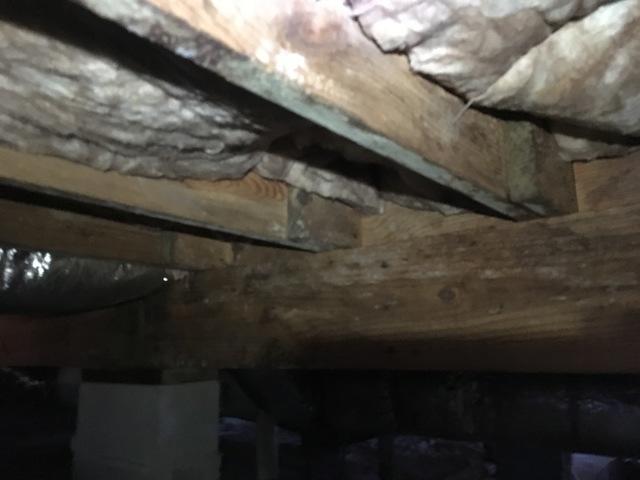Williamsburg, VA Sealed Crawl Space
Challenge
This Williamsburg, VA homeowner contacted us with several concerns in her crawl space. At her appointment, she expressed to Tony, one of our Home Performance Advisors, that she often had issues with freezing pipes in the winter, cold floors in her home, and water pooling on top of the vapor barrier.
During his inspection, Tony found that all of this homeowner’s concerns were completely justified. Water was pooling on the vapor barrier, mold was growing on the joists, and the fiberglass insulation in between the joists was dirty and offered little protection from cold floors and freezing pipes. After his inspection, Tony shared his findings with the homeowner, along with photos he took of her crawl space. He then discussed her options to treat the crawl space and prevent any of these symptoms from occurring again.
Tony presented this homeowner with several options for treating her crawl space. She opted for removing the old insulation and vapor barrier, an anti-microbial used to kill the mold on her joists, sealing the sill plate and crawl space vents, a new vapor barrier, new insulation, and a dehumidifier.
Solution
First, our install team, consisting of Bassam and Mohammed, removed all of the old insulation and vapor barrier from the crawl space. Next, they sprayed down all of the crawl space joists with Shockwave anti-microbial. This anti-microbial spray will kill mold/mildew but will not remove it. In this case, the homeowner also opted for the physical wipe down of the treated area. Performing the physical wipe down is an important step to ensuring the removal of the mold. If left on the joists, the dead mold would eventually dry and flake off becoming airborne. This airborne, dead mold can make its way into your home and affect your indoor air quality. (50% of the air you breathe in your home comes from the crawl space).
Next, the crawl space vents and sill plate are sealed. Vents are blocked with foam board insulation and seams are sealed with spray foam insulation, the same material used to seal the sill plate. The sill plate is where the frame of the home and the foundation meet and these two do not always sit flush with one another. This allows pests and air carrying moisture to enter your crawlspace. By sealing the sill plate and crawl space vents, you are helping to deter pests and control the amount of air carrying moisture that is entering your home’s foundation.
Next, a heavy gauge vapor barrier (moisture barrier) is installed. The liner is laid out and its seams are overlapped and taped. The liner is also wrapped around all the piers and adhered to the crawl space walls. The R-11 vinyl faced fiberglass insulation is then fastened to the crawl space walls and sealed against the liner. Insulating from the crawl space walls and sealing the earth off from the house extends the home’s thermal envelope to the floor of the crawl space. This helps control temperature and relative humidity, helping to solve the homeowner’s concerns of cold floors and freezing pipes.
The final piece of the puzzle is the installation of a dehumidifier. Any humidity or musty odors that occur in your crawl space will affect the air quality in your living space. The SaniDry™ Sedona dehumidifier removes moisture from the crawl space preventing mold, mildew, and bacterial growth. The installation of the dehumidifier won’t only keep the crawl space dry, but it will help keep the whole home drier and healthier.






